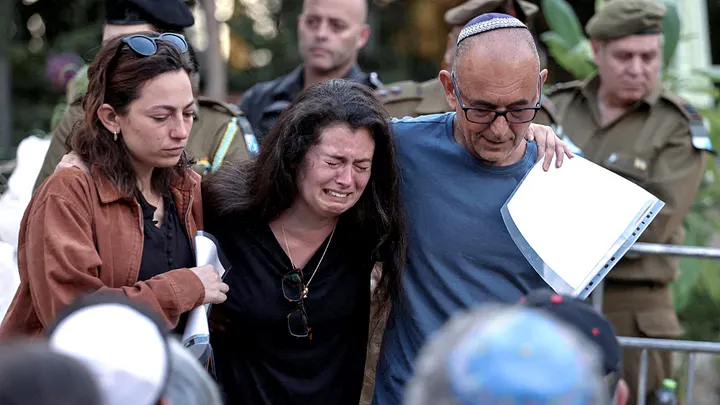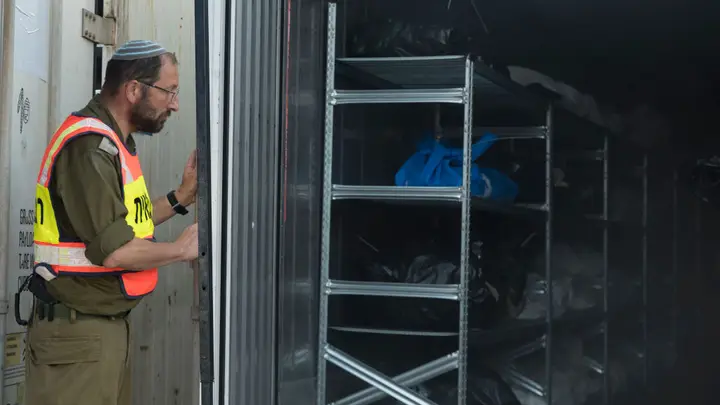‘When you think about evil, you realize it is beyond comprehension’
Three weeks after Hamas’ deadly massacre of multiple Israeli military bases, civilian communities, and a music festival, Israel is still struggling to identify its dead, not least because of the size and scope of the shocking, multi-pronged terrorist attack. Those who are working to identify the dead say that thousands of Palestinian terrorists have been brutalized.
At the Shura army base on the outskirts of the central Israeli city of Ramle, corpses and hacked-up body parts continued to pile up this week, still arriving in refrigerated trucks from the country’s south.
The actress says she ‘made contact’ with aliens: ‘They touched my face’
At the base, army personnel and volunteers, as well as religious officials handling the delicate process, described witnessing atrocities reminiscent of the Holocaust — images not often depicted in a country whose foundations stem from the Nazi genocide of Jews in World War II.
“During the war, each side tries to make a convincing case that they are right, but we haven’t seen these kinds of atrocities since the time of the Nazis,” said Colonel Rabbi Haim Weisberg, head of the army’s rabbinic department. Interview.
“They went from house to house and shot family after family,” he said. “We’re still seeing trucks coming in full of body bags containing entire families — grandparents, moms, dads, and even little kids being unloaded from the trucks.”

“Ordinarily, the rabbis at this base deal with dead soldiers, but this time it was unusual,” said Weisberg, who is one of several involved in the identification process.
“Here we have identified hundreds of dead bodies and many more are waiting to be examined,” he said.
Weisberg explained that some bodies are so badly burned that simple DNA testing is useless. In many cases, dental forensic teams were called in and had to track down the victims’ personal dental records. In some severe cases, even those methods are not effective.
The Israeli military confirmed that more than 1,400 people were killed in the attack and an additional 239 were taken hostage in the Palestinian enclave, with another 100 people missing.
Since the October 7 attack, IDF special forces have engaged in localized raids inside the Gaza Strip to recover bodies and body parts. Inside the devastated communities that sit along the Gaza border, forensic archaeologists are called in to search for human remains. Earlier this week, a human jaw was found in a burn-safe room.
Families, including those who hope their loved ones are still alive despite being held hostage by Hamas, are regularly informed that their relatives are among the dead.

Speaking in Shura, Weisberg described in graphic detail how a badly burned body turned into two victims – a mother and baby locked in a deep embrace. He said the other victim, who was pregnant, had her stomach cut open, her fetus removed and her head beheaded. The umbilical cord is still attached.
“When you think about evil, when you see what this terrorist organization has done, you realize it’s incomprehensible,” the rabbi said.
The grueling work at Shura takes place in a large white tent surrounded by rows of refrigerated containers. Inside each dusty box were dozens of carefully wrapped bodies and small bags containing babies and toddlers or body parts. The smell is overwhelming.
Along with military personnel and religious figures at the site, a group of women volunteers were also tasked with cleaning the bodies of the murdered women. The group is part of a special military reserve set up a decade ago to deal with female combat soldiers killed in action.
“They wanted to have women who could deal with the burial and identification process so they wouldn’t fall on the young soldiers and protect the privacy of the young women,” said Shari, one of the volunteers. Named because of military guidelines.

Shari said the team was specially trained by the army to deal with mass casualties, but they were not called into service until October 7. Since then, the unit has been functioning 24 hours a day, she said.
“I saw things that no one should see,” Shari said, noting how many of the dead women arrived still in their pajamas, their heads blown off and some held hostage by grenades.
“We saw evidence of rape,” Shari said. “Pelvises are broken, and it takes a long time to break a pelvis and it ranges from little kids to grandmothers. These are things we’ve seen with our own eyes.”
